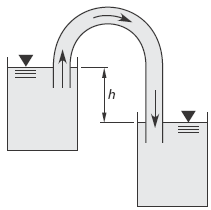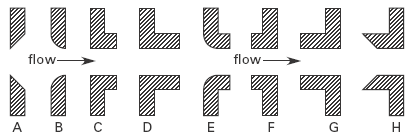Related Resources: calculators
Siphon Discharge Rate Calculator
Civil Engineering Application & Design Resources
Fluids Flow Design and Engineering
Siphon Discharge Rate Equations and Calculator
A siphon is a bent or curved tube that carries fluid from a fluid surface at a high elevation to another fluid surface at a lower elevation. Normally, it would not seem difficult to have a fluid flow to a lower elevation. However, the fluid seems to flow “uphill” in a portion of a siphon. Figure 1 illustrates a siphon.
Starting a siphon requires the tube to be completely filled with liquid. Then, since the fluid weight is greater in the longer arm than in the shorter arm, the fluid in the longer arm “falls” out of the siphon, “pulling” more liquid into the shorter arm and over the bend.
Operation of a siphon is essentially independent of atmospheric pressure. The theoretical discharge is the same as predicted by the Torricelli equation. A correction for discharge is necessary, but little data is available on typical values of Cd. Therefore, siphons should be tested and calibrated in place.
Preview Siphon Discharge Rate Calculator
Eq. 1,
V = Cd · Av = Cd · A ( 2 · g · h )0.5
Where
V =
volumetric flow rate, ft3/sec, m3/s
A = area of siphon discharge, ft2, m2
h =
height difference of liquid, ft, m
g =
gravitational acceleration,
32.2 ft/s2, (9.81 m/s2)
Cd = Approximate Orifice Coefficients for Turbulent Water, see Table 1
Figure 1 Siphon Configuration

Illustration |
Description | Cd |
A |
sharp-edged | 0.62 |
B |
round-edged | 0.98 |
C |
short tube* (fluid separates from walls) | 0.61 |
D |
sharp tube (no separation) | 0.82 |
E |
short tube with rounded entrance | 0.97 |
F |
reentrant tube, length less than one-half of pipe diameter | 0.54 |
G r |
eentrant tube, length 2 to 3 pipe diameters | 0.72 |
H |
Borda | 0.51 |
(none) |
smooth, well-tapered nozzle | 0.98 |
*A short tube has a length less than approximately 3 diameters.
Illustrations for Table 1

Source:
Civil Engineering Reference Manual, Fourteenth Edition
Michael R. Lindeburg, PE
Related
- Siphon Flow Rate Equation and Calculator
- Siphon Flow and Discharge Rates
- Fluid Discharged Distance Coordinates Equations and Calculator
- Vertical Tank Draining Time Formulas and Calculator
- Hooghoudt's Drainage Rate Equation and Calculator
- Time to Drain a Conical Tank Equation and Calculator
- Spherical Tank Draining Time Formulas and Calculator
- Horizontal Tank Draining Time Formulas and Calculator
- Orifice Plate Flow Calculations and Design
- Orifice Plate Type Flow Detector Review
- Orifice Submerged in Liquid Discharge Rate Calculator and Equation
- Nozzle Venturi and Orifice Flowmeter Formula and Calculator
- Gas Flow Rate Through Orifice Equations and Calculator per. ISO 5167
- Discharge of Air Through An Orifice Equation and Calculator
- Velocity Escaping Compressed Air Equation and Calculator
- Time to Drain a Conical Tank Equation and Calculator